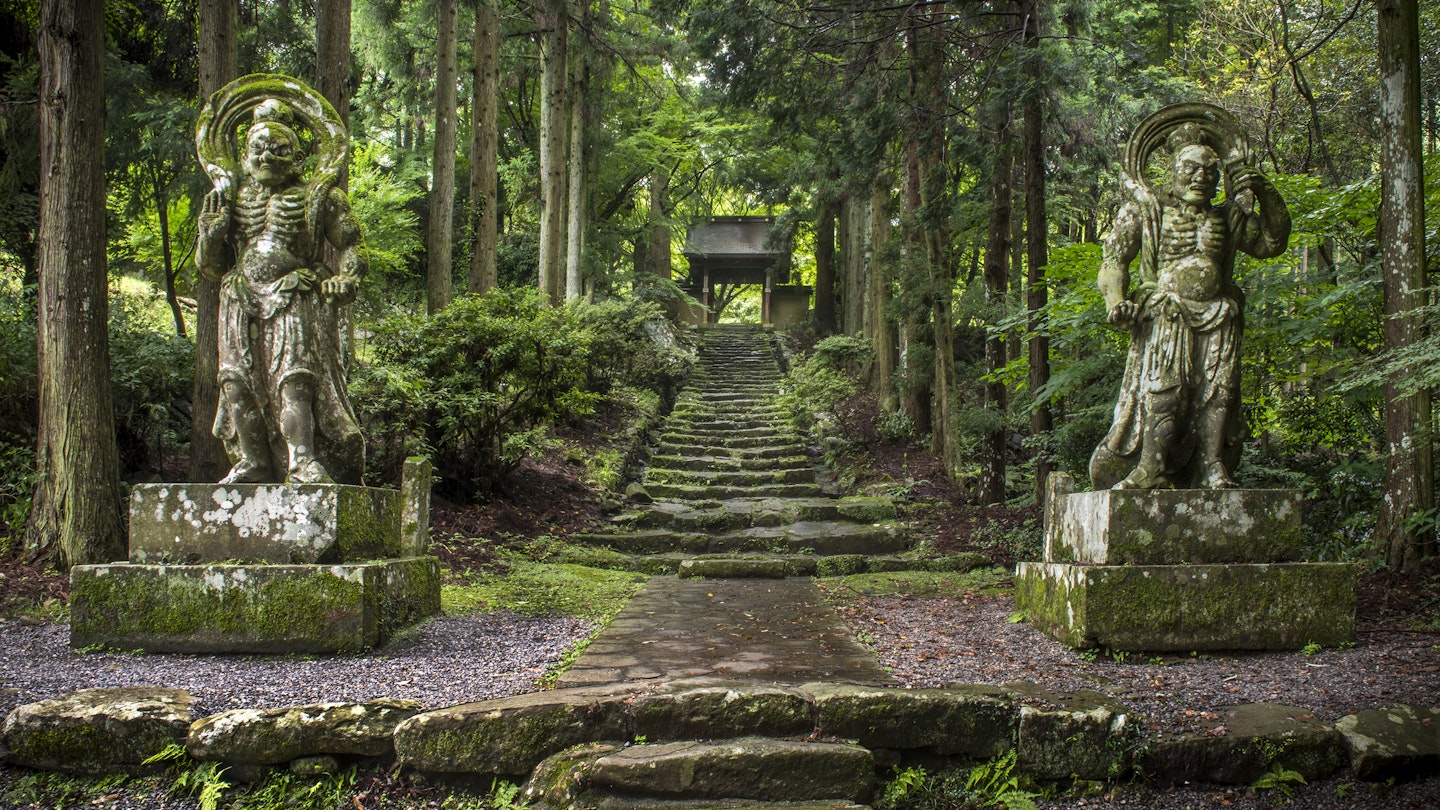Oita, a prefecture on Japan’s southern-most island of Kyūshū, is world-famous for its incredible hot springs. Towns like Beppu host bathers from around the world. Yet there’s so much more than onsen bathing to do here that it’s a bit of a mystery as to why people aren’t flocking to explore the other parts of this magical spot that are often overlooked. Here are six fantastic, less-visited spots in Oita Prefecture.
Kunisaki Peninsula
You couldn’t ask for more mystery than at Kunisaki Peninsula, where some of Japan’s largest, oldest, and most mystical Buddhist temples lie carved into hillsides or in wooden structures that date back to the 700s. The region is mountainous and rural, making getting here a bit challenging without a car. However, a bus tour comes daily to several of the most popular sites. Futago-ji Temple is perhaps the most famous, featuring a lovely temple complex split by a winding stream, with mossy trails, cedar-shadowed statuettes, and fascinating relics. Nearby, Fuki-ji Temple, established in 718, is the island’s oldest wooden building, rumored to have been built from a single fallen tree during the Heian Period. At the Kumano Magaibutsu, you can ascend a steep stairway to view two giant buddhas carved into a cliff. The peaceful surroundings of Usa Jingu Shrine on the western side provide a serene setting for exploration.

Taketa
The city of Taketa offers an onsen, an arts center, and a hidden Christian church nestled into a hillside near a famous samurai castle. This unique history remains clouded in mystery, particularly since Buddhism was the primary religion while Christians were often purged. Nearby, you can visit a relatively untraveled Bukeyashiki (historic Samurai street) showcasing beautiful villas. Visitors to Taketa can enjoy crafting bamboo at the arts center or soak in the unique Nagayu onsen, renowned for its highly carbonated water. There’s also a scenic castle ruin and a distillery for the delicious barley-based shōchū (strong Japanese liquor). Additionally, look for Kabosu liqueur, a unique citrus liquor made from the local citrus.

Hita
This charming city, known as the ‘Kyoto of Kyūshū,’ is little known among Western tourists, yet it boasts unique festivals, beautiful walking and shopping streets, and the distinct aroma of cypress from numerous logging and plank-making factories. You can smell the freshly cut wood in the air as you walk around. Hita’s ‘Sennen Akari’ festival, held the second week of November, transforms the night into day as thousands of bamboo lanterns illuminate the city, creating a magical atmosphere. For a memorable souvenir, purchase a pair of traditional geta (clogs) crafted from local wood. At one end of the most iconic shopping street, you’ll find a giant cypress ball that signifies a brewery/distillery, where you can visit a sake shop that has preserved its historical charm for centuries.

Onta
This tiny, secluded pottery town is a true hidden gem known only to locals. Located in the mountains near Hita, the potters of Onta dig their clay and process it with centuries-old techniques. As you stroll down the main street, you can witness the various stages of pottery-making, from greenware ready for glazing to blocks of clay drying in the sun and finished pieces for sale. While newer potters are introducing innovative designs, traditional patterns feature white slip hand-scratched with concentric tic-marks, spiraling outward from the center. One of the most remarkable sights is the method of grinding clay using giant water-powered mortars, producing a heartbeat-like sound that resonates as you approach.
The Kujū Mountains
If city life is wearing you down, consider escaping to Kujū-san, the highest mountain range in Kyūshū. You may choose to summit one of the many breathtaking peaks (Nakadake being the highest) or enjoy a leisurely picnic in the grassy highlands under the expansive sky. This spectacular region of Oita remains largely unexplored by many Western tourists, making it a perfect destination for outdoor enthusiasts. Grab a walking stick, put on your hiking boots, and embark on this adventure.

Rakan-ji and Nakatsu
This picturesque temple nestled in a serene valley once had limited access, requiring travelers to brave narrow paths over dangerous cliffs or along a precarious riverside. Remarkably, a monk devoted over 30 years to carving a tunnel entirely by hand to bridge the village, which has since been expanded and paved. Yet, glimpses of the original chisel marks remain. Inside Rakan-ji Temple, a poignant area commemorates ‘lost children’ using unique ema (prayer boards) fashioned from rice spoons. While the atmosphere is dark and somber, the view from the cliff offers a serene, calming perspective over the rustic valley. Additionally, a chairlift transports visitors over the treetops to the summit, providing an exhilarating experience. Nearby, the beautiful Yabakei Gorge and a quaint reservoir further enrich the area’s tranquil ambiance.
GoTravelDaily has produced this article for Oita Prefectural Tourism Association. All editorial views are those of GoTravelDaily alone and reflect our policy of editorial independence and impartiality.





